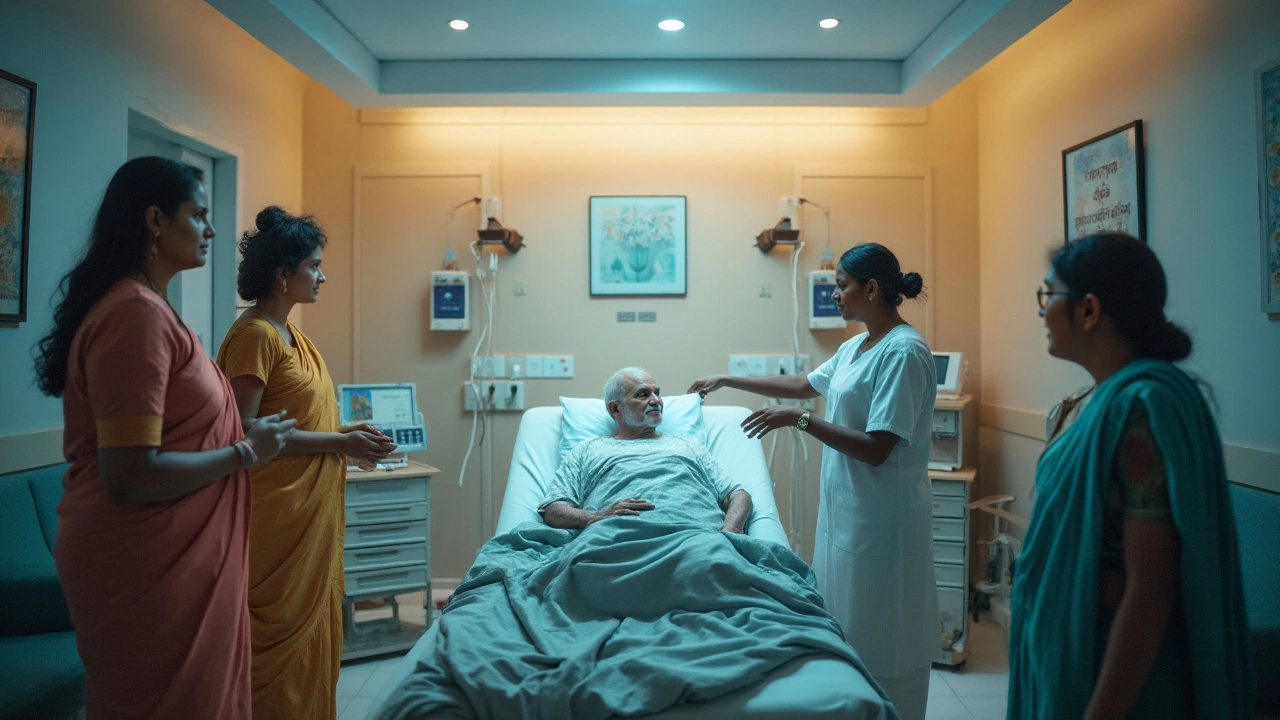Undergoing knee replacement surgery is a major life event that calls for thoughtful preparation and patience during recovery. The journey to regaining full mobility isn't just about the surgical procedure itself but also centers on the care taken immediately afterward, especially when it comes to bed rest.
While it might sound counterintuitive, bed rest after such a surgery isn't typically about long periods of inactivity. Medical professionals often advocate for a blend of rest and gentle movement, which seems to play a critical role in a successful recovery journey. Knowing how to balance rest with increasing activity levels can be quite beneficial.
In this article, we delve into the considerations and expectations of bed rest following knee surgery. With practical tips and expert insights, it aims to provide clarity and direction to those embarking on the road to recovery.
- Understanding Bed Rest Post-Surgery
- Expected Duration of Bed Rest
- Tips for Comfortable Recovery
- Managing Movement After Surgery
Understanding Bed Rest Post-Surgery
When discussing recovery from a knee replacement, the topic of bed rest surfaces frequently, often sparking varied opinions and questions. In the past, prolonged bed rest was seen as essential, but modern medical practice has shifted dramatically. It focuses on a more balanced approach—one that combines adequate rest with gradual, monitored movement. This isn't just about taking it easy, but about your body finding a rhythm that aids healing and rehabilitates effectively. The idea is to keep the blood circulation steady, which helps prevent complications like blood clots, and at the same time mitigate stiffness that wants to set in during complete immobility.
Within the first few days post-surgery, bed rest majorly consists of keeping the operated leg elevated and supported to ease swelling and pain. Elevating the leg above the level of the heart can do wonders for minimizing inflammation, a common issue in early recovery. Yet, that doesn't mean lying in one position for extended periods. Changing positions regularly is crucial to improve circulation and prevent pressure sores. During this early phase, a physical therapist might introduce gentle exercises. Their purpose is simple but vital—enhancing flexibility, ensuring the new joint gains range, and preparing you for more advanced stages of rehabilitation. Often, these exercises aren't executed solo. They require guidance to ensure movements are safe and effective.
Many healthcare professionals highlight that the body tends to heal better when it's active in a controlled manner. Dr. Sarah Connolly, a renowned surgeon specializing in orthopedics, remarks,
"Mobilization after a knee replacement is like oil to an engine—it keeps things running smoothly and helps patients get back on their feet quicker."The focus on early movement echoes widely across medical studies, which consistently show improved long-term outcomes for those who incorporate movement sooner rather than later. Now all of this requires sticking to instructions. More than just following doctor's advice, it's about listening to the body's feedback, which often whispers the subtle differences between productive pain and harmful discomfort.

Expected Duration of Bed Rest
The journey toward recovery after a knee replacement often raises a prominent question: How long should one stay in bed post-surgery? Though it is natural to assume that extensive bed rest is necessary, the reality is pleasantly different in many cases. Medical practitioners today lean towards a more dynamic recovery process that starts with controlled mobility relatively soon after the procedure. This change in approach stems from a growing understanding of how movement aids the body in healing and restoring function.
Typically, patients begin with partial weight-bearing activities as early as the day after the operation. Walking with the aid of crutches or a walker becomes an integral part of early recovery. Contrary to age-old practices of long static bed rest, this approach aims to reduce complications like stiffness or blood clots, which can be more common in complete immobility. Encouragement towards mobility doesn't mean bed rest is eliminated; it remains a critical component, particularly during the initial weeks when the body demands substantial healing time. Bed rest is balanced with gentle, supervised exercises to enhance muscle strength and joint flexibility.
Why Movement Matters
It's important to underline why movement is encouraged. Muscles and joints thrive on activity for maintaining their function and resilience. A sedentary lifestyle post-surgery can pose risks, not only in delaying recovery but also in impacting mental health. Depression and anxiety can sneak in when days are monotonously spent idle. This understanding underscores the gradual return to activities which, while daunting initially, pay rich dividends in the long run. Notably, as the American Academy of Orthopaedic Surgeons notes, "The encouragement towards movement promotes the release of endorphins, which plays a crucial role in pain management and improving mood."
Adapting to the routine of gentle motion can seem intimidating, but with proper guidance, it soon morphs into a daily rhythm. Caregivers and medical professionals play pivotal roles in this phase, stepping in to offer support groups and setups where patients can exchange experiences, thus easing the recovery process. A shuffle down the hall or standing for brief periods during the day becomes achievable goals to aim for, setting the groundwork for a more active lifestyle on the horizon.
"By steering clear from extended periods of complete inactivity, patients often find their recovery accelerated, experiencing lesser complications and improvements in range and strength," explains Dr. John R. Tongue, an orthopedic surgeon respected in the field for his insight into post-operative care.
Ultimately, the road to recovery after a knee replacement is a collaborative effort between the patient and their medical team. While bed rest has its place, the emphasis on recovery through movement progressively takes center stage, ushering patients toward a quicker and complication-free return to their daily routines.

Tips for Comfortable Recovery
Recovering from knee replacement surgery can be daunting, but maintaining comfort during this time is crucial for both physical and mental well-being. The path to regaining strength and mobility involves a few key strategies that ensure your days in bed and gradual return to activity go as smoothly as possible. One of the most vital factors is establishing a relaxing environment around you. Arrange your living space in a way that reduces the need to move unnecessarily, keeping essentials like medications, remote controls, and water within easy reach. Comfortable bedding with ample cushioning can reduce any undue pressure on your new joint, aiding the healing process.
The importance of ice packs cannot be overstated. Regular application of ice helps to minimize swelling – a common post-surgical effect – and alleviates discomfort. Ensure you have at least two ice packs on rotation so that one is always ready while the other is being used or refreezing. Coupled with this is the necessity for following prescribed pain relief protocols. Pain management isn't just about comfort; it significantly impacts recovery speed and quality of life post-surgery. Prioritize discussions with your healthcare provider to ensure a plan tailored to your needs.
Diet also plays a substantial role in recovery. Adequate nutrition not only accelerates healing but also enhances energy levels, which are crucial when daily activities start increasing. Focus on meals rich in protein to support muscle repair and include plenty of fruits and vegetables for vital vitamins. Staying hydrated is equally important, so keep water bottles on hand to promote regular fluid intake. Recovery isn’t just about rest; it’s about tapping into a holistic approach that combines nutrition, rest, and activity.
"Engaging in prescribed physical therapy exercises is essential," notes Dr. Jane Doe, a leading orthopedic surgeon. "These programs are designed to improve your mobility, reduce stiffness, and strengthen the muscles surrounding the knee, which is crucial for a successful recovery." This emphasis on movement underlines the importance of not falling into the trap of prolonged inactivity, which can lead to complications such as stiffness or weakened muscles.Finally, maintaining a positive mental outlook can dramatically affect your recovery. It's normal to feel impatient or frustrated, especially when progress seems slow. Engaging in activities that uplift your mood, whether that’s reading, meditating, or catching up with loved ones, helps pass the time and keeps your spirits high. Pairing these with regular feedback from physical therapists and doctors can help reassess goals and progress, offering encouragement and reassurance.
Remember, every person’s journey to full recovery after knee replacement may differ, but harnessing these key tips ensures you're setting yourself up for a smoother ride ahead. Take the time to prioritize your comfort, manage expectations, and celebrate small victories. These elements together weave the fabric of a healthy recovery experience.

Managing Movement After Surgery
After knee replacement surgery, managing movement might seem daunting, but appropriate timing and consistency in movement are crucial for a successful recovery. Generally, early mobilization is a key component in recovering effectively and restoring full function of the knee. This doesn't imply rushing into activity, rather engaging in controlled and supervised movements that cater to healing. Understanding the delicate balance between rest and activity can significantly affect surgical outcomes.
Initiating movement typically begins within a few days post-surgery, often while still in the hospital. Patients might start with simple exercises aimed at improving blood circulation, reducing the risk of blood clots, and decreasing swelling. The initial focus is often on the ankle pumps, quadriceps sets, and gentle bending and straightening of the knee. Each of these exercises is designed not only to enhance recovery but also to boost the patient's confidence in their newfound capabilities.
A physical therapist usually devises a tailored plan, which not only guides progress but also attends to individual pain levels and any surgical complications. According to a study published in the Journal of Orthopaedic & Sports Physical Therapy, patients who engage in a structured physical therapy regimen tend to experience better mobility outcomes than those who remain inactive.
"Movement is an essential aspect of recovery; it aids in strengthening the muscles and tissues surrounding the knee, reducing stiffness and promoting healing," notes Dr. Andrew Ross, a well-known orthopedic surgeon.With movement playing such a vital role, daily commitment to exercise is generally encouraged. It often starts with movements while lying down and gradually progresses to standing exercises. Learning to walk with an assistive device like a walker or crutches is another critical step during this phase. As the days go by and strength builds, patients can expect their endurance and balance to improve significantly.
Tracking progress can offer beneficial insights as well. A simple knee replacement recovery tracker, which may include recordings of increased walking distance, reduced pain levels, and enhanced flexibility, can be immensely motivating. Additionally, it's common to see significant improvement within the first two to four weeks post-surgery, a timeframe that aligns with most medical guidelines.
Importantly, adherence to prescribed exercises not only supports physical healing but also plays a critical role in mental well-being. The feeling of regaining control can be a substantial mood booster. While the journey isn't without challenges, those who persist in their exercise regimen often experience a quicker, more comfortable return to normal activities and enhanced satisfaction with their knee replacement.
